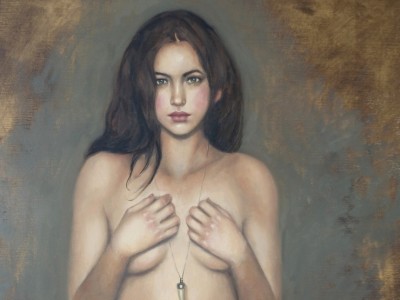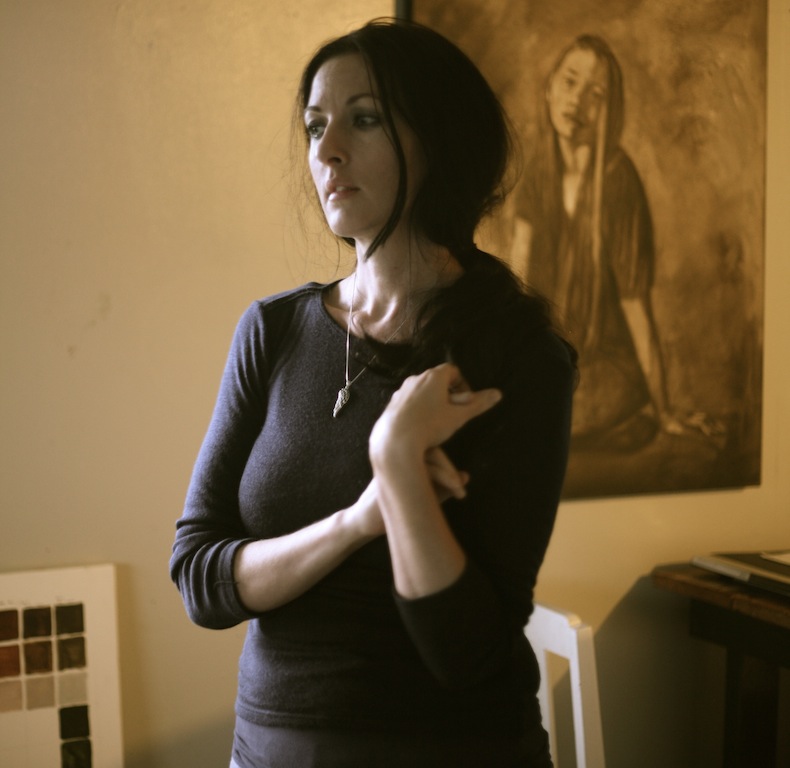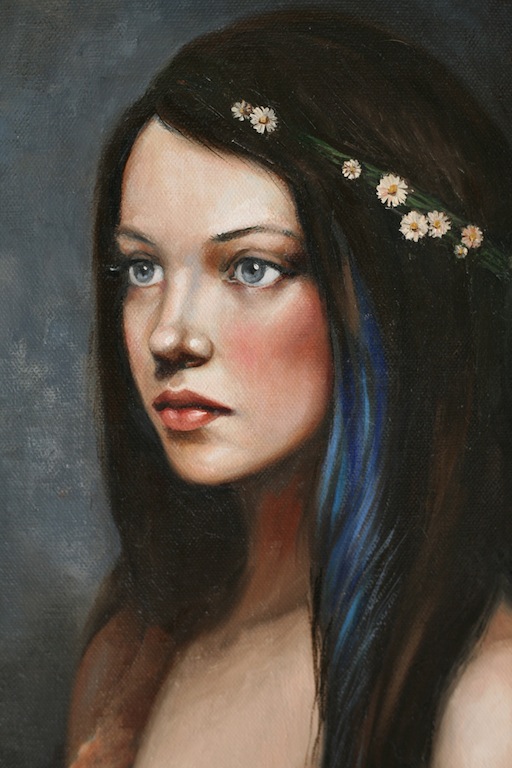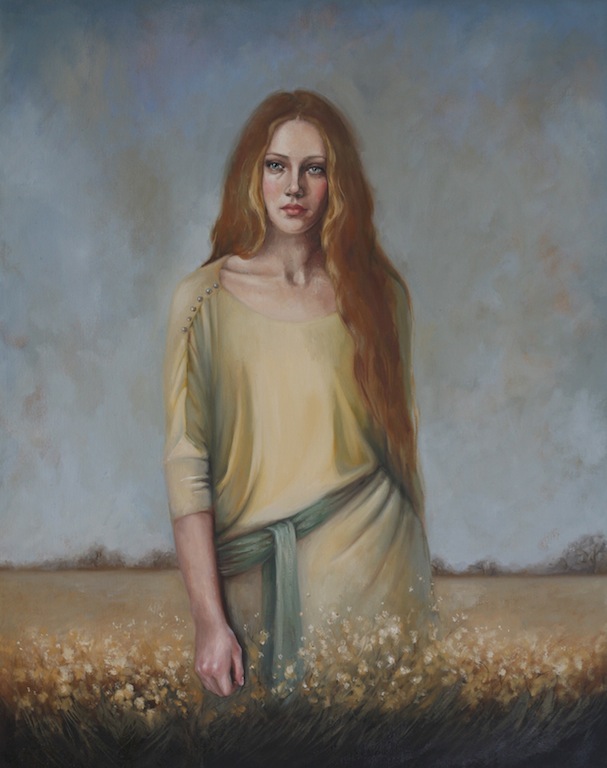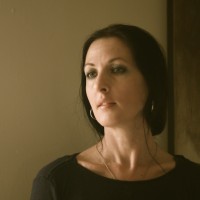[Image: “The Keepsake” (oil on canvas, 2013)]
You hold a variety of diplomas, including teaching and interior design. How have your other programs of study influenced your artistic work?
My diploma of Interior Design taught me basic color theory, composition, and importantly taste. Beautiful design, Elegant design, Bohemian design, Artisan design. It was this period I lived in Napier, “art deco capital” of New Zealand. I discovered the Victorian aesthetic, the arts & crafts movement and art nouveau. Rather than choosing objects based upon price or practicality, in a simple ordinary life, I discovered how enriching existence became to surround yourself with things you find beautiful and wonderful or are passionate about….
I felt a kindred spirit in William Morris whose concern was that technology was destroying human craftsmanship and eventually would cripple the human spirit. He encouraged hand craftsmanship, which in turn would enable individuals to achieve satisfaction and pleasure in their work. Furthermore, Morris demanded that good quality furnishings should be available to all and not just the wealthy.
Regrettably I understand, much like Morris, these two aims are at odds with each other, as handcrafted goods are often much more expensive than machine made products. But I believe today we still live with the quandary of how much technology is improving the life of the individual.
My Diploma of Teaching really taught me I didn’t fit. My nature flourishes when I have an outcome and I am left alone to accomplish this. It takes me time to orientate myself and I have to think or draw through all of the steps I must take. I get very intolerant to have to comply with steps that seem redundant. I was able to minor in art which kept me sane during this time. My classes with art tutors Chris Morley and Don Ratana are still some of my fondest memories.
What was your formal art education like?I came to art in the time when expression was valued over instruction, methodology and technique. I resent my high school art, as it knocked my confidence so completely. In small town New Zealand access to beautiful traditional artwork is somewhat limited, I was in my thirties before I saw some of these pieces in the flesh.
Nasty nightmare-faded 70’s prints of Frans Hals pieces with their creepy smiles haunting our art room day after day like creepy clown paintings leave me favoring the reserved “Leonardo smile” or the Mary Cassatt “lost in her own world gaze” for my women.
The rule of no smudging or blending ever, still leaves me with an internal battle when attempting tonal drawing or multilayered painting. Lack of exposure to the classical work I love left me somewhat defenseless and inept against the expressionist prejudices of my high school art teacher.
My “Diploma of Art and Creativity with Honors” did not specifically focus upon realism, in fact I was cautioned against limiting myself so early in the course. TLC instructors like Catherine Hayes who focused on accuracy in drawing and Mark Spratt, who made drawing fabric over and over seem exciting, provided enough of a foundation for me to build upon. Laurel Barr, one of my wonderful tutors, who exposed me to fine artists. It seemed every time we spoke Laurel would say, “What you are working on reminds me of ‘so and so’—have you looked at their work? Although I found this difficult initially, what it led me to was an understanding and insight into reverse engineering the work of artists I love. It encouraged me to be brave enough to sit my work next to these artists and evaluate it honestly. To always keep looking, keep moving forward, when to try new things and when to “stay the course”.
What led you to choose to use handmade oils in the select colors that you do? Whose materials do you find suit your work best?
I came to the handmade oils through my typical roundabout route. I switched to oils from acrylics in 2008, without a clear understanding of how to apply oils. Initially I failed to adapt my technique and I found safflower oil-based paints and water-based oils did not suit me. In hindsight, had I seen the work of Mary Whyte or Koo Schadler I would have gone to watercolor or egg tempera.
My partner comes from a chemistry background and we spent a day, which became three weeks, online researching MDS sheets and product reviews. Without the help of Virgil Elliot, three weeks could easily have become three months. Some companies were very open and clear about their product, and I like that. We decided that linseed oil or walnut oil seemed to be the most stable. I also wanted to avoid a couple of other chemicals for doubts about their longevity.So Williamsburg became my primary paints with a few pigments from Gamblin & Old Holland. I use paints with no more than two pigments and preferably one. I try to keep my main palette to under 24 colors, I always buy these in larger tubes as otherwise I have a tendency to starve my palette.
I love Williamsburg earth pigments. I see them as the anchor of my work. My favourites are the standard umbers and ochres and blacks. In contrast the native earths are gritty and have a texture like “jellywhip” which I love to use to soften the clunky pigments or add substance to the transparent pigments. Texture is very important to me. My favourite color is a crimson PBr175 from Old Holland which is hard to find, I use it to tone down my quindaricridones and enhance my earth reds without losing their richness.
You name three modern artists as inspirations for your work: Nelson Shanks, Odd Nerdrum, and Andrew Wyeth. What is it about each of these artists you are drawn to, and that inspires you?
I must confess I am an obsessive magpie when it comes art and artists now. If I listed all the artists work I followed it would be a long list, some are a fleeting fancy others like Waterhouse, Bouguereau and Goldie have been favourites for years.
1. Odd Nerdrum
Nerdrum’s work speaks to that part of me, that is the outsider, the solitary individual. He paints stories, timeless mythologies and I feel I know the story without needing the words. They are so soulful, so rich, so deep I feel as if I am being consumed by them and drawn into them. And I marvel at how an image in a book is so full of power.
Then comes technique which is so fascinating to me—how can it appear so loose and so muddy close up, and stand back and its crisp and clear and glowing, and so full of form…I now understand Late Titian, Rembrandt, GF Watts amongst others used these techniques.
2. Wyeth
Wyeth’s visions speak to me of home. A quiet, quirky, melancholic, dark, aloneness that is warm and comforting and sublime.
Wyeth’s life is f everything I would have loved my life to be. A warm loving family. A father who was artist himself who openly taught his children. A childhood where imagination and play and work and love existed. A whole lifetime dedicated to art and a place to call home.
3. Nelson Shanks
Shanks’ women make me smile, always. Cheeky, strong, full of sprit, daring you to look at them as they stare back at you from the canvas. The opulence is spellbinding and many of the props rescued by Shanks himself from ignorant renovations of John Singer Sargent’s London studio.
I am awe of how he takes such bright vibrant color, and loose broad brushwork and creates such compelling form and subtle skintones. I am far more structured and timid in my methodology, far more conservative in my current aesthetic, but I feel Shanks’ work keeps me pushing myself further, being braver, taking more risks.
You mention on your artist’s website that you are “the quintessential reclusive artist.” What settings or conditions (time of day, level of quiet, weather, interior/outdoor space, etc.) help you to do your very best work?
I prefer grey moody days and even light. Warm, not hot. An expansive space inside, with a big window (better with good view to get distracted out of). Clean and hyper organised is my ideal, but I am messy. I work on at least ten paintings at a time, and I pile resources and color swatches on every available surface till I trip or knock something over, then a whirlwind tidy up follows….
I don’t like interruptions and prefer to be alone (with my Staffordshire Terrier/ painting buddy). If someone is there I don’t mind them talking but find moving about quite distracting. My studio ranges from very quiet (sounds of the farm) to very loud music from my eclectic tastes including Metallica, Disturbed, Breaking Benjamin, Pink, to Mumford & Sons and the Thomas Oliver Band.
You had to switch to left-handed painting after breaking your right wrist in 2010. How are things going for you three years on? Would you say you are now ambidextrous as an artist? In what ways has switching from your dominant hand changed your projects and your process?
I think it has limited me as a person, but grown me as an artist. In 2010 I was at a crossroads with my work, looking to whether I wanted to go more photo realist or more tonal & atmospheric.
Unfortunately, the wrist is still not better.
I’m not fully ambidextrous yet, I automatically use my right and have a paint shirt which pins the right hand back. I can write quite legibly with my left hand, and lay on color quite confidently but its not yet steady enough to trust for fine detail. I cannot draw yet to a satisfactory level, which I miss most. I used to sit at an easel to paint, now I always work standing, at a purpose built table that I can adjust the top from 45-85 degrees.
I have had to investigate more formal traditional multilayered work, as I usually work directly. Plan work in sections, with a focus on smaller works. Four years ago my average size piece 40×40”now 20×16”. I expect as I get more efficient with traditional methods I will work on larger pieces again.
You live in rural Horowhenua, on the west coast of New Zealand. What do you enjoy doing when you are not creating art?
I love the country landscape and being surrounded by animals. My favourite thing is escaping my three cats and wandering with my daughter and staffordshire terrier on the beach or round our little village. I especially love Winter and Autumn here with the abundance of old deciduous trees marking the passage of time (most native New Zealand trees are evergreen, so the trees where I live are quite special).
I am very lucky with my partner going onto the family farm the last few years and my mother-in-law, Sylvia Kay, trains and owns racehorses, which she has been quite successful at over the many years. So I get to be surrounded and entranced by these beautiful animals.
Before breaking my wrist, I loved sewing, I love sumptuous fabrics. Though my sewing was always average at best. This has been somewhat replaced by poring over art books, or reading Jungian psychology, astrology, mythology and old story.

